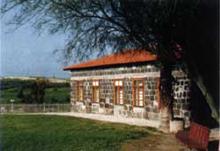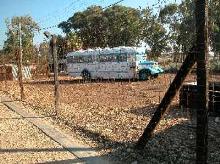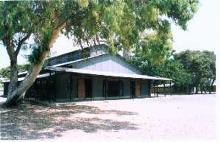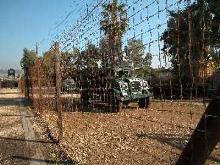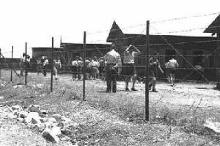| Miscellaneous |
'Beit Habitachon' in kibbutz Beit Keshet The house was transformed into a museum so as to commemorate the Palmach settlements and encourage settling in the Galilee. Site director - Mr. Moshe Chalfon Tel: 04- 6629216 Rural delivery Lower Galilee 15247 The old Gesher Courtyard and Battles Museum Near kibbutz Gesher, on the Jordan river banks, is "Old Gesher" - a hidden scenic spot of geo-political and historical significance: A border, 3 bridges, a junction and railroad track, an ancient 'Chan' fortress and a British police fortress. Across the border from it is Pinchas Rotenberg's Power Station - "The old man from Naharayim. " The Old Gesher Courtyard tells the story of Jewish settlement in the area from the turn of the century, especially the Gesher battles during the War of Independence. It was the first settlement that faced an attack by a mandatory army - the Jordanian Arab Legion - in April 1948, and was at the center of Iraqi invasion with the declaration of independence in May 1948. Kibbutz Gesher was under siege and was completely destroyed. After a night evacuation of children, injured and non-fighting population, it turned to a post held by Haganah members and volunteers. The warriors withstood the entire War of Independence. Recent restoration and reservation work, including gardening and signage has been done on the ruins, turning the Gesher Courtyard into an educational site for pupils, groups and families. Battles Museum The museum is located in an underground shelter, which was the heart of the settlement during the War of Independence battles. The museum depicts the war story through its displays. Alongside a documentary display of documents and weapons, it artistically emphasizes the semi-civilian aspect of the underground life, the children's lives, the health clinic and kitchen, the folklore and morale. A digital map illustrates the battles, which were strategically significant in preventing the disconnection from the North by invading armies. The Naharayim Power Station model: Informs about the pioneering work of Pinchas Rotenberg and can serve as starting point for a tour of the floodgates and canals: Opening Hours: Sunday-Thursday and Saturday - 10:00-14:00 Friday and Holiday - 09:00-13:00 Advanced booking required for groups Entrance fee is charged Phone number: 04-6752685 Fax: 04-6709387 'Revivim' Observatory The museum's goal Israel to teach the history of settling in the Negev, the Zionist settlement in the new era, irrigation and agriculture methods, and self-defense during the War of Independence. The site combines an in-door and out-door museum. The sites and objects date back to 1943-1949: Military posts, bunkers and communication tunnels. The camp itself has objects and tools that demonstrate the life-style of that period: Communications and boarding rooms, showers, mess hall, club room, shack, weapons room, a display of agricultural tools and the first tractors. As part of the irrigation display are the dam, the leading canal, pools, leveled garden-beds, and salty water garden-beds. The site offers two guided tours; one of 2 hours and another of 4 hours, including a 15-minute audio-visual presentation. Tel-Hai Courtyard A 100-years old basalt courtyard with a red-tiled roof, surrounded by lawns and shaded areas and overlooking Emek Hachula, Ramat-Hagolan and the Upper Galilee Mountains. The historical structure is under renovation until 9/3/06, after which it will resemble kibbutz Tel-Hai on the 11th of Adar, 1920, and tell the story of Tel-Hai from its roots to its legacy. The historical structure is surrounded by agricultural tools, and among them important statues of the "Tel-Hai Arts Event" from 1980-1944. An audio-visual presentation in 7 different languages tells the heroic story that served as a turning point in the history of Zionism. Children are offered written quizzes and coloring pages and are invited to dress up and take photos in period garments. Atlit Detention Camp The Atlit Detention Camp was pronounced a national site. The disinfection structure and some of the shacks were restored and reconstructed as an initiative by the Society for Preservation of Israel Heritage Sites, the Atlit Local Council, and the Society for Preservation of Atlit Detention Camp. The site serves as an educational center for teaching the history of Illegal Immigration to Israel and commemorating the courage of warriors and immigrants. The site features exhibitions and displays from the camp life, the immigrants and immigration efforts; an audio-visual presentation; interactive multimedia computer games; and a historical, educational library for student projects. The site also offers seminars, tours, simulation games, conferences, youth movement camps and 'Shelach' activity. Address: Atlit Detention Camp P.O Box 189 Atlit 30350 Tel: 04-6941565 Fax: 04-9842814 Director: Zehavit Rotenberg Visiting Hours: Sunday-Thursday 09:00-17:00, Friday 09:00-13:00. On holidays and Friday evening - 09:00-13:00 and closed on Saturday and holidays. Group visits may be scheduled in advance for different hours. Duration of visit: 1- 1½ hours; with activity - 4 hours. On site guidance: Advanced booking for groups and individuals. Entrance fee: Entrance fee is charged Introductory material is available as well as books and postcards. | |||||||||||

